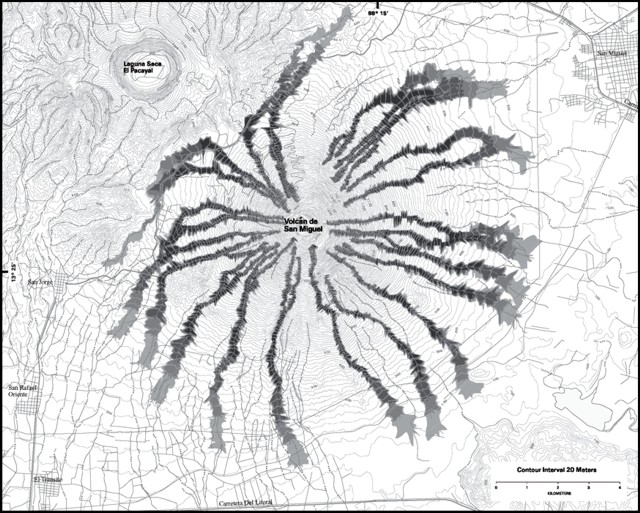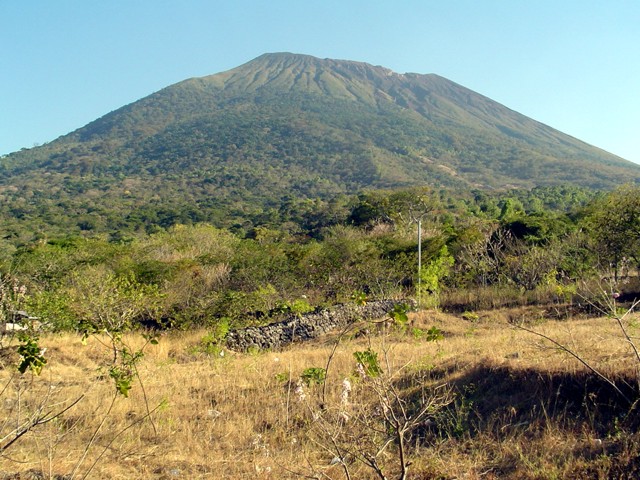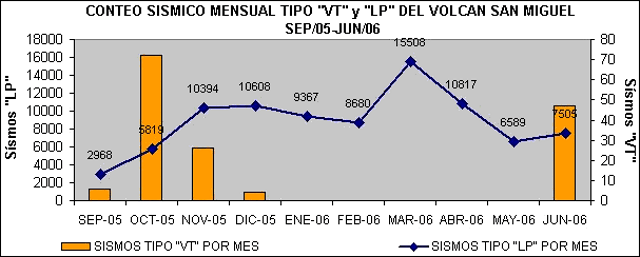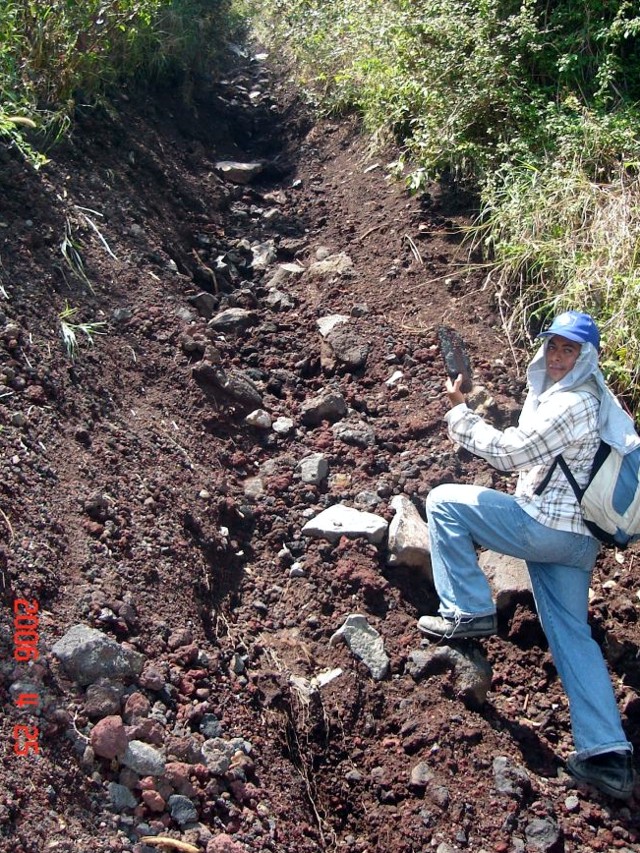Report on San Miguel (El Salvador) — October 2006
Bulletin of the Global Volcanism Network, vol. 31, no. 10 (October 2006)
Managing Editor: Richard Wunderman.
San Miguel (El Salvador) Restlessness persists during 2005-6; heavy tropical rains trigger lahars
Please cite this report as:
Global Volcanism Program, 2006. Report on San Miguel (El Salvador) (Wunderman, R., ed.). Bulletin of the Global Volcanism Network, 31:10. Smithsonian Institution. https://doi.org/10.5479/si.GVP.BGVN200610-343100
San Miguel
El Salvador
13.434°N, 88.269°W; summit elev. 2130 m
All times are local (unless otherwise noted)
According to El Salvador's Servicio Nacional de Estudios Territoriales (SNET) activity levels at San Miguel have generally remained similar to those during January 2002 when a minor plume rose above the summit crater (BGVN 27:02). The volcano's vigor continued into at least October 2006 at a level slightly at or above the base line of normal activity.
Recent publications have discussed the volcano and its lahar-hazard potential (Escobar, 2003; Chesner and others, 2003; Major and others, 2001). Figures 1 and 2 are taken from the latter publication.
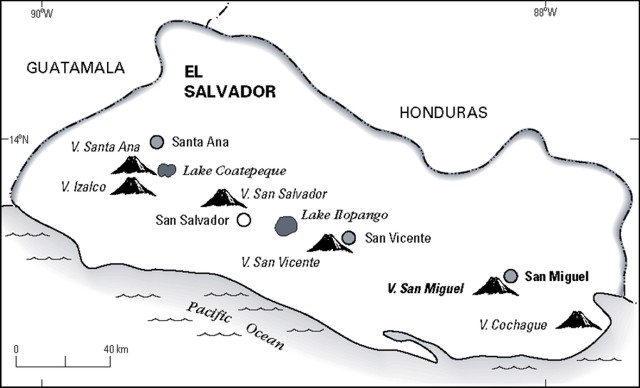 |
Figure 1. Index map indicating El Salvador's volcanic front and the location of volcan San Miguel. Major cities are also shown (circles). From Major and others (2001). |
In January 2005 observers saw new fumaroles as well as small landslides on the N and SW wall of the crater. The accumulation of mass-wasted material in the crater led to a rise in the elevation of the crater floor.
During February 2005, weak fumaroles and small rock landslides persisted in the central crater. Digital sensors installed there recorded fumarolic temperatures in real time. On the outer portions of the cone the terrain is steeply sloping and contains prominent gullies (figure 3).
The SNET reports for March and April 2005 noted that the crater was structurally weak due to the fumarolic activity, ongoing rock alteration, occasional landslides, and fractures on the western plateau. Microseismicity had increased; but it did not exceed typical base-line levels. Workers at the Santa Isabel farm (finca) noted N-flank lahars after heavy rains during March. The N flank contains abundant fine-grained volcanic deposits of the sort easily swept away during times of heavy rain.
Intense rains during May 2005 were associated with tropical storm Adrian (over an unstated interval the meteorological station near the volcano, San Miguel UES, recorded 428 mm of rainfall). As a result of the deluge, fumarolic activity from the crater increased. The crater walls remained intact, but eroded material previously deposited in the central crater that was poorly consolidated had to some degree stabilized. Substantial further compaction, settling, or collapse in the central crater seemed to have ceased by July 2005. During August 2005 the crisis at volcan Santa Ana forestalled visits to San Miguel.
A spike in seismic activity occurred during August 2005, with 7,048 long-period earthquakes, compared to July 2005, with 2,239 long-period earthquakes. SNET reports noted that based on monitoring, San Miguel generally remained within its base-line of normal behavior during the reporting interval. Figure 4 shows a histogram of long-period and volcano-tectonic events from the SNET reports for the interval September 2005-June 2006.
On 14 September 2005 a visiting group (OIKOS- Soliradaridad Internacional) made a trek to the summit and videotaped the scene there. SNET said the video disclosed a lack of significant changes in the crater; however, they saw debris-flow deposits in summit drainages on the volcano's outboard flanks. The visitors described both sounds of degassing and moderately intense odors of H2S. During the course of September the seismic system recorded several minutes of tremor.
The October 2005 SNET report noted that workers at the plantation Santa Isabel noted N-slope lahars associated with rainfall. The lahars were also described as small debris flows; they descended from the high-elevation headwater areas, which are steep sided and narrow. The November report commented about the quantity of debris-flow material accumulating at the base of some N-flank channels. The same report also mentioned that moderate degassing was seen in the crater leaving areas of abundant sulfur, which appeared as yellow zones in one or more fumarolic areas.
The November 2005 report of SNET also discussed substantial landslides inside the crater that were followed by widening of the funnel-shaped area of collapse in the central crater. The landslides had left three distinct perched remnants of the crater floor (small terraces) at various elevations on the crater walls. The crater's western plain (one such terrace of the sort mentioned above) was stable but showed areas of subsidence (figure 5).
Lahar monitoring during December 2005 disclosed erosion of easily mobilized cinders and scoria material on the N to NW flanks during the previous wet season. December seismicity was elevated, but cracks in the crater changed little compared to previous measurements. A field team visited the summit on 11 January 2006 and again in February and found few substantive changes in the crater. On the ascent route during January, the team saw a small recent "fall of material" reaching 40 cm thick. Some fumaroles discharged yellowish gases. During February the team conducted measurements of cracks on the western plain but found few changes, suggesting the headscarp had moved little if at all. February and March tremor episodes were centered at ~ 5 Hz and lasted 1-3 minutes.
The March 2006 SNET report noted small rockslides on the crater's N and S sides and, with the beginning of the rainy season in March 2006, there was a potential for the development of lahars. During the March visit the team found abundant granular material in the gullies on the NW flank, judged to be the result of debris flows. Monitored cracks remained stable.
With the arrival of the wet season in April, lahars and enhanced fumarolic output became apparent. One debris flow intersected a highway. On 23-24 April, 105 mm of rain was recorded at plantation (finca) Santa Isabel. Figure 6 shows the results of one lahar which left a trail of debris during the rainy interval. Earlier in the month on the 16th, a tremor or multi-phase episode lasted over an hour.
In April 2006, an increase in fumarole degassing within the crater and small landslides contributed to the instability of the deposits on the NW flanks of the volcano. Steam emanated from the fumaroles occasionally forming a weak column that reached the edge of the crater. There was a slight increase in seismicity throughout the month. Seismic activity increased in March and April 2006 (figure 4). Rocks in the crater show intense hydrothermal alteration with a yellowish reddish color. Small rock landslides were observed in the N and S zone of the crater.
During June 2006, the temperature of the fumaroles, opening of cracks and the gas discharge by the crater of the volcano, remained stable. There was an increase of small landslides within the crater. The analysis of the seismicity indicates that the volcano is slightly above its base line of normal behavior. New landslides and cracked rock were observed in the walls of the crater (figure 7). Rains have transferred volcanic material down the NW flank. Seismicity gradually increased in both frequency and magnitude beginning on 16 June. 47 VT earthquakes and 7,505 LP earthquakes were recorded, an amount that surpasses those registered in May; but smaller than those registered in March and April (figure 4).
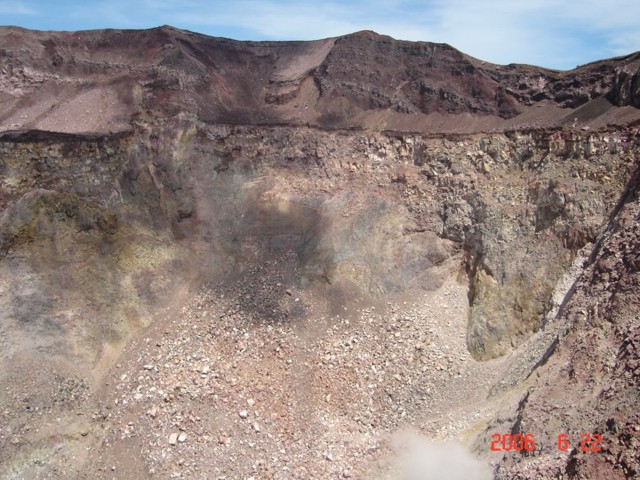 |
Figure 7. San Miguel's S crater wall exposes zones of altered and fractured rocks. A planar zone of structural weakness appears towards the right. Photo taken on 22 June 2006. Courtesy of SNET. |
During July 2006, stability continued with respect to fumarole temperatures, crack openings, and gas emissions around the crater. However, the seismicity increased by ~ 70%. Small and sporadic landslides took place inside the crater off the SE to SW walls. Intense hydrothermal alteration in the NW wall was also observed. SNET did not report any lahars during July 2006; however intense rains have continued to remove volcanic material from the NW flanks. The fumarolic field gave off weak emissions.
In August 2006, the monitored parameters such as fumarole temperature, crack opening, and visual estimates of gas discharge maintained normal levels. The seismicity diminished significantly in relation to July.
During September 2006, San Miguel reached a low level of activity. There were no significant changes in the morphology of the volcano as reported in previous months. At the S wall, there were evidence of small rock slides.
A sudden increase in seismicity occurred on 9 October 2006. Contact was made with other observatories and it was determined there were no landslides or rock falls associated with the event. Seismic increases such as 9 October had previously occurred, particularly on 19 June 2003 and from 2-6 May 2004. The 9 October increases were attributed to gas emission from the crater.
References. Chesner, C. A., Pullinger, C., Escobar, C. D., 2003, Physical and chemical evolution of San Miguel Volcano, El Salvador. GSA Special Paper 375.
Escobar, C.D., 2003, San Miguel Volcano and its Volcanic Hazards; MS thesis, Michigan Technological University, December 2003. 163 p.
Major, J.J.; Schilling, S.P., Pullinger, C.R., Escobar, C.D., Chesner, C.A, and Howell, M.M., 2001, Lahar-Hazard Zonation for San Miguel Volcano, El Salvador: U.S. Geological Survey Open-File Report 01-395. (Available on-line.)
Geological Summary. The symmetrical cone of San Miguel, one of the most active volcanoes in El Salvador, rises from near sea level to form one of the country's most prominent landmarks. A broad, deep, crater complex that has been frequently modified by eruptions recorded since the early 16th century caps the truncated unvegetated summit, also known locally as Chaparrastique. Flanks eruptions of the basaltic-andesitic volcano have produced many lava flows, including several during the 17th-19th centuries that extended to the N, NE, and SE. The SE-flank flows are the largest and form broad, sparsely vegetated lava fields crossed by highways and a railroad skirting the base of the volcano. Flank vent locations have migrated higher on the edifice during historical time, and the most recent activity has consisted of minor ash eruptions from the summit crater.
Information Contacts: Carlos Pullinger, Seccion Vulcanologia, Servicio Geológico de El Salvador, c/o Servicio Nacional de Estudios Territoriales, Alameda Roosevelt y 55 Avenida Norte, Edificio Torre El Salvador, Quinta Planta, San Salvador, El Salvador (URL: http://www.snet.gob.sv/Geologia/Vulcanologia/).


